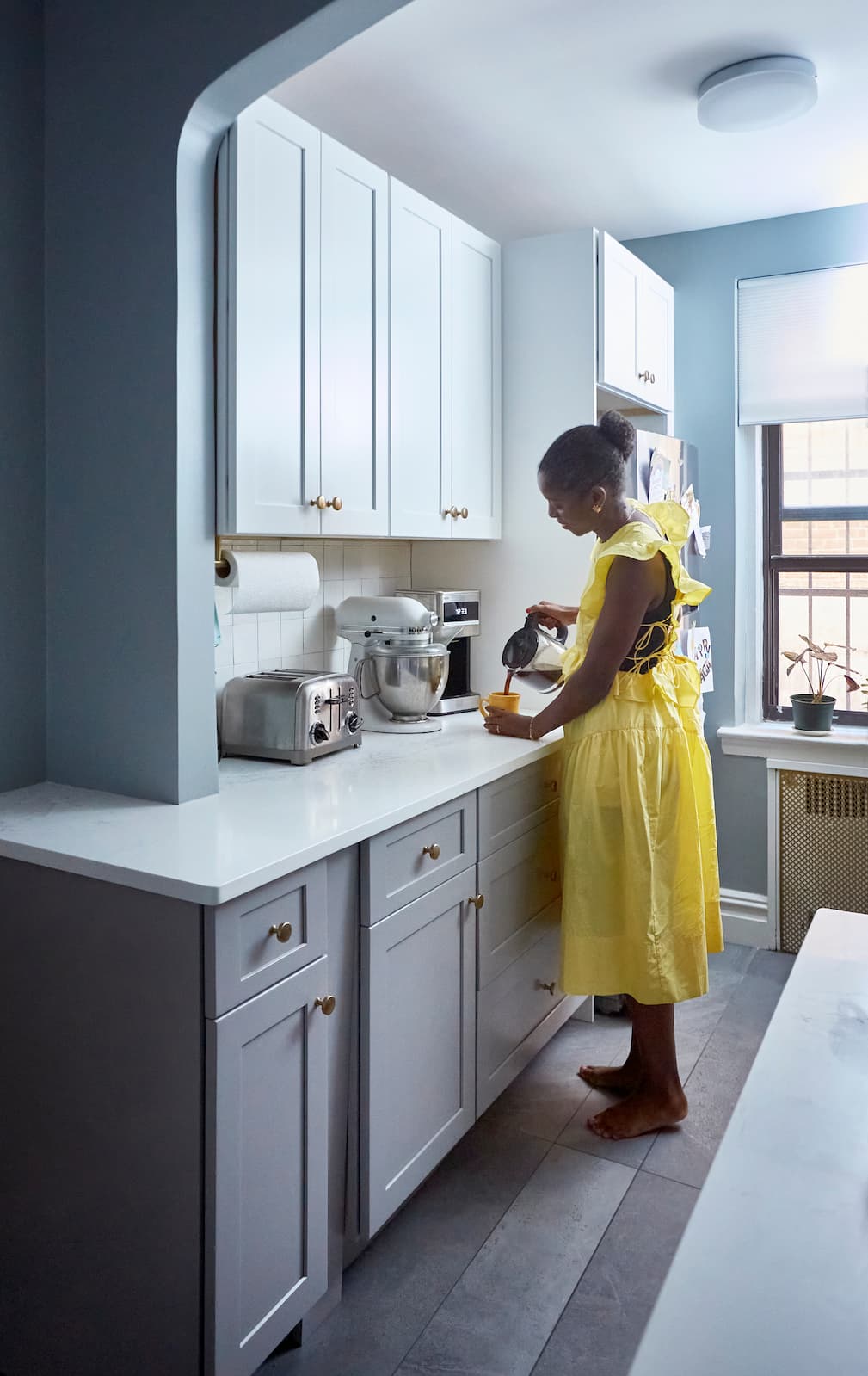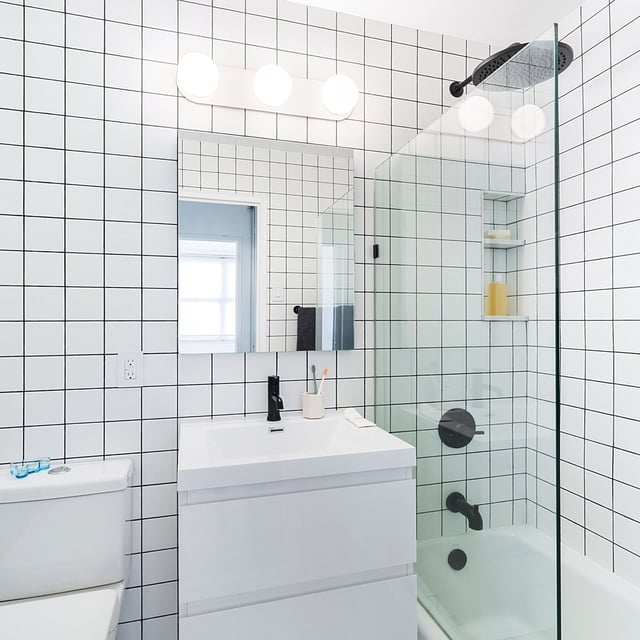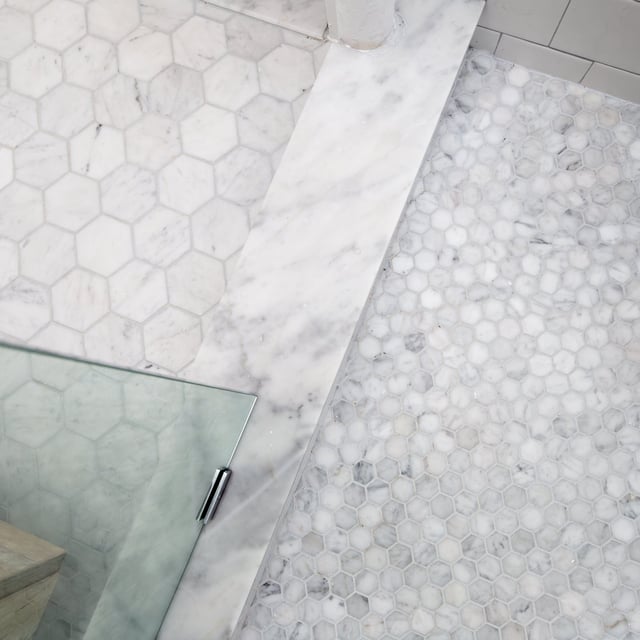
Tile
Subway Tile Pattern Guide: Vertical, Herringbone & More
11.15.2025

In This Article
Designing a modern bathroom is as much about texture and detail as it is about fixtures and layout—and tile plays a big role. The right mix of tiles can bring energy, depth, and personality to the space. Contemporary bathroom tiles open up countless possibilities, whether you like bold contrasts or softer, more subtle pairings. In this guide, we’ll walk through smart ways to combine shapes, colors, and materials so your bathroom feels intentional and distinctly yours.
Learn how much it costs to tile a bathroom
One of the hallmarks of contemporary bathroom tiles is the creative use of contrasting shapes. For example, pairing large rectangular wall tiles with small hexagonal tiles around the vanity or shower can add visual interest and depth.
This New York homeowner chose to combine stone-colored rectangular tiles with a hexagon mosaic, creating a sophisticated yet approachable look.

For other fun ideas, try mixing subway tiles with penny rounds, or combine square floor tiles with elongated wall tiles for a modern twist. Don’t be afraid to experiment with scale—oversized tiles can make a small bathroom feel more expansive, while smaller shapes add texture and detail. The key is to balance the proportions so the space feels cohesive, not chaotic. To explore this topic further, read What Size Tile Is Best for a Small Bathroom? Pros and Cons of Small vs. Large Tiles.
Color contrast is a powerful tool for creating a contemporary vibe in your bathroom. For example, this bathroom features soft taupe wall tiles paired with crisp white marble in the shower. The colors balance one another out for a nuanced aesthetic that walks the line between soothing and energetic.

Want other ways to mix bathroom tiles of varying colors? Consider using dark floor tiles with lighter walls, or vice versa, to ground the space and draw the eye. For a more subtle approach, try mixing different shades of the same color family—think charcoal and dove gray, or navy and sky blue tiles. If you’re feeling bold, introduce a pop of color through a feature wall or a band of accent tiles. Remember, the best bathroom tile combos use color to highlight architectural features and create a sense of flow.
Perfect Every Detail of Your Bathroom

You don’t have to use wildly different tiles to achieve a contemporary look—sometimes, it’s all about how you lay them out. This New York bathroom showcases a clever mix of white subway tiles on one wall and the same tiles arranged in a herringbone pattern on another. This approach creates visual movement and keeps the design feeling fresh without overwhelming the space.

Try running tiles vertically on one wall and horizontally on another, or use the same tile in different sizes for added dimension. Mixing tile sizes and configurations is a subtle way to add interest while maintaining a unified palette. This technique works especially well in bathrooms where you want a clean, modern feel with just a hint of playfulness.
Combining different tile materials is a hallmark of bathroom contemporary tiles. This California bathroom combines classic white subway tiles with wood-look porcelain planks in the shower, creating a warm, spa-like atmosphere. Mixing glossy and matte finishes, or pairing natural stone with ceramic, can add depth and tactile interest.

Let your creativity run wild! Perhaps use marble on the floor and ceramic on the walls, or introduce a glass mosaic as a border or accent. When mixing materials, pay attention to the undertones—cool grays and warm beiges can clash if not carefully coordinated. The right bathroom tile combination will feel layered and intentional, not random.
If you love the idea of a statement bathroom, don’t shy away from bold colors or patterns. For example, this bathroom features a playful combination of patterned tiles in a recessed shelf, paired with a deep green vanity and mustard yellow accents. Use a single wall, niche, or floor section to showcase a vibrant tile, while keeping the rest of the space more neutral. This approach lets you experiment with trends—like geometric prints or encaustic tiles—without overwhelming the room.

For a cohesive look, echo the accent color in your towels, accessories, or cabinetry. Mixing tiles in the bathroom is all about balance: let one element shine while the others provide support.
Bring Your Dream Bathroom to Life

Choosing the right bathroom tile combos can feel overwhelming, but our free Bathroom Remodel Visualizer makes it easy. Upload a photo of your space or use our sample rooms to experiment with different bathroom tiles combinations, colors, and patterns. Instantly see how mixing tile sizes or materials will look in your own bathroom, and save your favorite designs to share with your contractor. It’s the fastest way to turn inspiration into a plan you love.
Try our Bathroom Remodel Visualizer
Once you’ve found your perfect bathroom contemporary tiles, the next step is finding the right professional to bring your vision to life. Block connects you with thoroughly vetted, experienced contractors who specialize in contemporary bathroom renovations. Our team reviews every project scope, provides transparent pricing, and supports you from start to finish—so you can remodel with confidence.

Written by Block Renovation
How should I choose which color grout when mixing tiles?
How long does it take to re-tile a bathroom?
Does it matter which tiles go in the shower?
What kinds of tiles are considered most economical?

Renovate confidently with Block
Easily compare quotes from top quality contractors, and get peace of mind with warranty & price protections.
Thousands of homeowners have renovated with Block

4.5 Stars (100+)

4.7 Stars (100+)

4.5 Stars (75+)

Tile
Subway Tile Pattern Guide: Vertical, Herringbone & More
11.15.2025

Tile
Natural Stone Kitchen Flooring: Tile Types, Cleaning Tips & Design
10.13.2025

Tile
Grout Color Guide: Enhancing White and Colored Tiles
08.27.2025

Tile
Best Materials for Bathroom Floor Tiles
08.21.2025

Tile
Mixing Bathroom Tiles for a Contemporary Look
08.21.2025
Renovate confidently